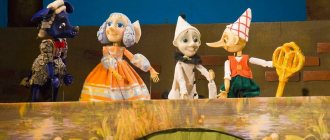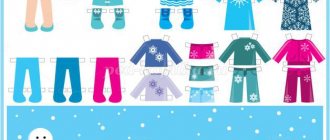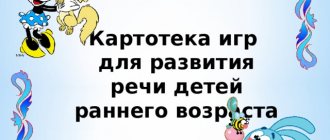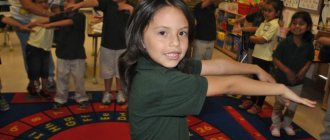Progress of the game.
Children hold hands and walk in a circle, in the center of which is the driver; children sing a nursery rhyme and perform movements.
At Malanya's, at the old woman's, (They walk in a circle and sing.)
Lived in a small hut
Seven daughters
Seven sons
All without eyebrows! (They stop and, using facial expressions and gestures, depict what is said in the text.)
With eyes like these
With ears like these
With such noses
With such a mustache
With such a head
With such a beard...
We didn’t eat anything, (They squat down and prop their chin with one hand.)
We sat all day.
On him (her)
looked
They did it like this... (Repeat any gesture after the leader.)
A. Barto “Toys”
Tasks:
Introduce poems.
Teach children to perform characteristic actions when reading again, repeating lines of text after the teacher
To develop the ability to convey basic emotions through facial expressions, gestures, and movements. Encourage children's willingness to participate . Used tabletop theater
Fairy tale "Kolobok"
Tasks:
Arouse interest in theatrical play through the first communication experience
with the characters.
Invite children to follow the development of the plot based on illustrations,
Develop attention and visual - effective thinking;
Learn to name characters and their actions. Incorporate names into speech
animals and their signs; expand the active vocabulary: round, ruddy,
red-haired and cunning, club-footed, etc.
Theatrical game based on a fairy tale ( the theater on spoons , Bi-Ba-Bo is used)
Nursery rhyme "Cucumber, cucumber"
Cucumber, cucumber,
Don't go to that end
There's a mouse living there
He'll bite your tail off!
Tasks:
Teach children to pronounce a nursery rhyme. Mastering affectionate treatment
(cucumber, ponytail, mouse)
.
Develop attention, enrich vocabulary.
Cultivate careful behavior.
Option 2. Use in a game (the mouse lives there - the children run away
Theatrical nursery rhyme game (head masks are used)
Theatrical games
№ 1 "Let's take Mishka for a walk"
Goal: to develop object-based game actions; form accompanying speech.
Equipment: teddy bear, sled, crib, high chair, set of clothes for
bear cub (pants, felt boots, coat, hat)
.
Progress of the game.
Children are invited to go on a trip around the world. They must figure out where their path will lie - through the desert, along a mountain path, through a swamp, through a forest, a jungle, across the ocean on a ship - and change their behavior accordingly.
№ 7 “Mishka came from a walk”
Goal: to develop object-based game actions; form
accompanying speech.
Equipment: teddy bear, sled, crib, high chair, set of clothes for
bear cub (pants, felt boots, coat, hat)
.
Progress of the game.
The object is placed on a chair in the center of the circle or passed around the circle from one child to another. Everyone must act with the object in their own way, justifying its new purpose, so that the essence of the transformation is clear. Options for the transformation of different objects:
a) pencil or stick - key, screwdriver, fork, spoon, syringe, thermometer,
toothbrush, paint brush, pipe, comb, etc.;
b) small ball - apple, shell, snowball, potato , stone, hedgehog,
bun, chicken, etc.;
c) notebook - mirror, flashlight, soap, chocolate, shoe brush, game.
You can transform a chair or a wooden cube, then children must justify the conventional name of the object. For example, a large wooden cube can be turned into a royal throne, flowerbed, monument, bonfire, etc.
8. Grandma Malanya
Target. Develop attention, imagination, resourcefulness, ability to create
images using facial expressions, gestures, plasticity.
Progress of the game.
Using a rhyme, a child is selected to play the role of king. The remaining child workers are divided into several groups (3 — 4)
and agree on what they will do and what work they will be hired for. Then they approach the king in groups.
Workers. Hello King!
King. Hello!
Workers. Do you need workers?
King. What can you do?
Workers. Guess it!
Children, acting with imaginary objects, demonstrate various professions: cooking, washing clothes, sewing clothes, embroidering, watering plants, etc. The king must guess the profession of the workers.
If he does it correctly, he will catch up with the fleeing children . First
the caught child becomes king. Over time, the game can be complicated by introducing new characters (queen, minister, princess, etc.), as well as inventing the characters of the characters (king - greedy, cheerful, evil; queen - kind, grumpy, frivolous).
№ 6 "Trip around the world"
Target. Develop the ability to justify your behavior, develop faith and
imagination, expand children's .
Progress of the game:
Teacher in front of the children sitting at the table. There is a house on the table, from the window
which a bear cub is peeking out.
Teacher. Oh, whose face appeared in the window?
The children answer that it is a bear. The teacher takes him out from behind the house and draws the children’s attention to how the bear purrs when greeting them. Then he asks the children to purr in the same way .
Suddenly the bear hides behind the house.
Teacher: Teddy bear, playful Teddy bear!
Where are you? Where are you? Answer me!
Teddy bear, Naughty Teddy Bear!
Where are you? Where are you? Show yourself!
The bear's head appears in the window again. He shakes his head and purrs. Children imitate him. The display game is repeated at the request of the children . Various characters familiar to children can hide. And every time the teacher encourages the children to imitate the “voices”
these characters.
№ 3 "Finger Game"
Goal: to introduce children to theatrical activities ; teach them to combine
words with movements.
Equipment: finger theater .
Progress of the game.
With the help of a rhyme, a child is selected who invites the children to the “birthday”
. Guests come one by one and bring imaginary gifts.
With the help of expressive movements and conventional play actions, children
must show what exactly they decided to give.
No. 5 “King”
(version of the folk game)
Goal. Develop actions with imaginary objects, the ability to act
agreed upon.
Progress of the game:
Using a counting rhyme, the driver is selected. He leaves the room. The children agree on what and how they will portray. The driver returns and asks:
“Where have you been, boys and girls? What did you do?"
The children answer: “We won’t tell you where we were, but we’ll show you what we did.”
.
Children show the actions they came up with.
During the game, the teacher first advises what and how to depict.
When the children get used to it, he only suggests what to depict, and they decide for themselves how to do it.
6. Trip around the world
Target. Develop the ability to justify one’s behavior, develop faith and imagination, and expand children’s .
Project on theatrical activities in kindergarten. Junior group
Project on theatrical activities in the junior group “Visiting a fairy tale.”
Description: The project discussed in this publication is not completed, work on the project is in full swing. In this publication I would like to share with my colleagues the interim results of the project. The material may be useful to preschool teachers and parents of preschool children. Project theme: “A fairy tale has come to visit us”; Type of project: medium duration, role-playing, creative; Forms of work: group, frontal. Relevance of the project: A full-fledged education of a child of primary preschool age is possible only if the child is psychologically comfortable in the process of communicating with peers, adults in kindergarten and family. When a child enters kindergarten, it becomes stressful. Adaptation is difficult, with a lot of negative changes in the child’s body, which is manifested in the child’s behavior. When a child enters kindergarten, an adaptation period begins not only for him, but also for his parents. The situation of protracted adaptation of children and parents to the conditions of preschool educational institutions does not contribute to the full development of children. Therefore, there is a need to facilitate the adaptation period. This can be done by achieving emotional comfort for children and involving parents in the educational process through joint theatrical activities with children. Therefore, it becomes especially important to create conditions for theatrical activities on the territory of the kindergarten. One of the most effective means of developing and educating a child in early preschool age is theater and theatrical games. Play is the leading activity of preschool children, and theater is one of the most democratic and accessible forms of art, which allows solving many pressing problems of pedagogy and psychology related to artistic and moral education, the development of personal communicative qualities, the development of imagination, fantasy, initiative and etc. Theatrical activities are a source of development of feelings, deep experiences of the child, and introduce him to spiritual values. They develop the child’s emotional sphere, make him sympathize with the characters, and also allow him to develop the experience of social behavior skills due to the fact that every literary work or fairy tale for preschool children always has a moral orientation. In the process of theatrical play, the child’s vocabulary is activated, the sound culture of his speech and its intonation structure are improved, which is very important at this age. The role played and the spoken lines put the child in front of the need to express himself clearly, distinctly, and intelligibly. His dialogic speech and its grammatical structure improve. The goal of the project: to create conditions for the favorable adaptation of children in preschool educational institutions and the implementation of the tasks of the main general education program of preschool education through theatrical activities. Project objectives: 1. Create conditions for the psychological adaptation of children and their parents to the conditions of a preschool educational institution; 2. Introduce fairy tales through various types of theater; 3. Expand interaction with parents of students by creating a creative workshop; 4. Involve children in joint theatrical activities; 5. Form an idea of different types of theater; 6. Develop speech, imagination and thinking; Project participants: •educators Antonova T.G., Amirova G.R.; •children aged 2 – 3 years; •parents of pupils; Expected result: •favorable adaptation of children to preschool educational institutions; •creating a positive emotional environment of communication between children, parents and educators; •formation of skills to convey the character of fairy tale characters through expressive speech, facial expressions, and gestures; •equipment of the theater corner. Project products: •puppet theater: “Kolobok”, “Turnip”, “Ryaba Hen”, “Zayushkina’s Hut”, “Teremok”; •table theaters: “Kolobok”, “The Ox and the Seven Little Goats”; •finger theater: “Teremok”; •plane theater: “Hen Ryaba”, “Kolobok” •masks and attributes for theatrical activities: “Turnip”, “Teremok”, “Hare, Fox and Rooster”; •plot pictures, illustrations for fairy tales; •didactic games: “My favorite fairy tales”, coloring pages based on the fairy tales “Teremok”, “Kolobok”, “Turnip”, “Ryaba Hen”; Preliminary work: selection and study of pedagogical literature; reading Russian folk tales “Turnip”, “Teremok”, “Kolobok”, “Ryaba Hen”, poems, nursery rhymes, riddles about the heroes of fairy tales; listening to sound recordings of children's fairy tales - “The Wolf and the Seven Little Goats”, “Kolobok”, “Turnip”, “Teremok”, “Ryaba Hen”, “The Hare, the Fox and the Rooster”; attending puppet shows at preschool educational institutions; viewing toys and illustrations for fairy tales; complex of morning exercises - “Hen and Chicks”, “In a forest clearing”; Project implementation stages. 1. Preparatory; 2. Basic; 3. Final; Preparatory stage: 1. Visual information for parents: “Theater as a means of development and education of children of primary preschool age”; 2. Definition of goals and objectives; 3. Development of a project passport; 4. Individual conversations, consultations with parents to identify their interest in replenishing the theater corner, their abilities in one or another area of handicrafts and opportunities. Main stage: 1) Distribution of tasks between parents (sew costumes, knit masks, fill the corner with various theaters: tabletop, finger, puppet); 2) Organization of a morning reception for children: dressing up in costumes of various fairy tale characters; meeting children with fairy tale characters (using puppet theater); 3) Introduction to fairy tales: Fairy tale “Teremok”:
- telling the fairy tale “Teremok” with a puppet theater show;
- telling fairy tales with children using finger theater; — construction of houses for animals (teremka); — dressing up in costumes and dramatizing the fairy tale “Teremok”; - imitative movements of fairy tale characters and their voices; - didactic games: “Guess who I’m talking about”, “Who lives in the little house?”; - outdoor games: “The little gray bunny is sitting”, “By the bear in the forest”; Fairy tale “Turnip”:
- telling the fairy tale “Turnip” with a puppet theater show;
— telling the fairy tale “Turnip” together with children with a theater show on magnets; — modeling “Turnip”; — simulation exercises; - use of coloring books for the fairy tale “Turnip”; Fairy tale “Hen Ryaba”:
- telling the fairy tale “Hen Ryaba” with a theater show on magnets;
- telling the Russian folk tale “Ryaba Hen” using a tabletop theater; - singing children's songs “Cockerel, cockerel...”; — didactic games: “My favorite fairy tales”; — active game “Hen and Chicks”; Fairy tale "Kolobok":
- telling the Russian folk tale "Kolobok" with a tabletop theater show;
- modeling, drawing “Kolobok”; — dressing up in costumes and dramatizing the fairy tale “Kolobok”; — exercise “Pretend to be a hero”; - outdoor game: “Fox - fox”; - use of coloring books for the fairy tale “Kolobok”; Fairy tale “Zayushkina’s hut”:
- telling the fairy tale “Zayushkina’s hut” with a puppet theater show;
— designing houses for fox and bunny animals; - dressing up in costumes and dramatizing the fairy tale “Zayushkina’s Hut”; - imitative movements of fairy tale characters and their voices; - outdoor games: “The little gray bunny is sitting”, “By the bear in the forest”; Interaction with parents: replenishment of the theater corner; folder – movement “Theater as a means of development and education of children of primary preschool age”; consultations on organizing home puppet shows. Final stage: 1. Exhibition of works by parents: “Fairy Tale Workshop”; 2. Matinee “Teremok”; 3. Presentation of the project at a methodological association in a preschool educational institution; Project results: 1. Children adapt to the conditions of the preschool educational institution; 2. Parents have developed an interest in theater and joint theatrical activities; 3. Replenishment of the theater corner; 4. In independent activities, children improvise with characters from finger theater, tabletop theater and magnetic theater; 5. Children have formed an idea of various types of theater. The theater corner in our group is replenished and updated through the joint efforts of parents and educators. Our latest creation is the crocheted finger theater “Teremok”. In the next publication I will show a master class on making this theater.
We recommend watching:
Scenario for a puppet theater in kindergarten Scenario for a theater festival based on Pushkin’s fairy tales for older preschoolers Musical-themed fairy tale for older preschoolers with elements of life safety for preschoolers Do-it-yourself shadow theater in kindergarten
Similar articles:
Theatrical performance script for middle school children



